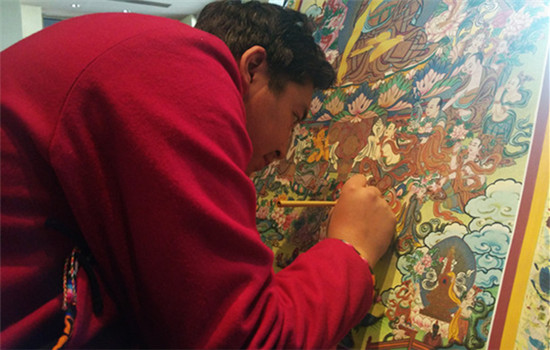
Kelsang Dawa shows his thangka collection at his painting center in Shangri-La, Yunnan province. The Tibetan art genre is energy-intensive-sometimes it takes years to finish one piece. (WANG KAIHAO/CHINA DAILY)
Compared with ancient pieces, Kelsang Dawa pays more attention to details, and sometimes gold powder is used in outlines.
He often spends months fully focused on a work. One 7-meter-long thangka took him and another painter two years to finish.
There are six longtime painters in his workshop, but dozens gather there in summer. He has compiled a textbook on thangka as their reference guide.
He is the son of a thangka painter and first picked up drawing pens when he was 6. The technique has been passed down in his family for more than 10 generations.
"When my father finished a work for a monastery, he was treated like a god at the ceremony. Though the work was very energy-intensive, my father only asked for some yak meat or butter as payment. For a thangka painter the most important thing is to earn pilgrim's homage."
Kelsang Dawa became a lama in a monastery of his hometown when he was 11, following a thangka guru.
"I had to be very diligent, like getting up at 5 am for practice. But the hardships were worth it. No one can be a qualified thangka painter without at least seven years' learning and practice."
That was just a part of his syllabus to hone painting techniques; the study of Buddhism classics also played an important role.
To get more inspiration he has traveled to India, Bhutan and Nepal.
"It's impossible to be a good thangka painter without in-depth research in Buddhism, and someone exposed to different cultures can also breed new thoughts."
Kelsang Dawa later went to New York to teach thangka to local people and college students. But he felt it was more important to teach Chinese people about the art of their country, so he returned to China in 2007.
His paintings still keep attracting foreigners.


















































